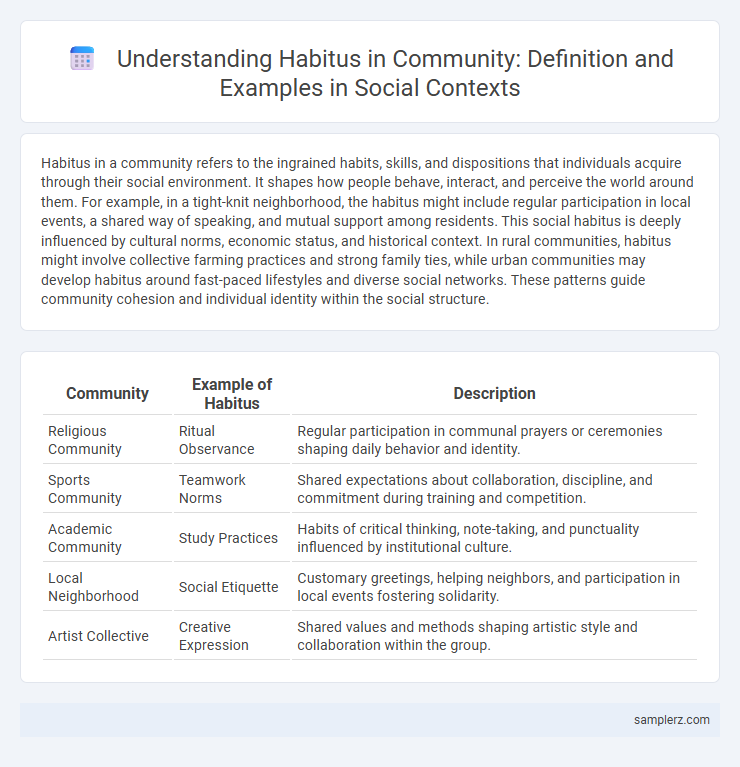Habitus in a community refers to the ingrained habits, skills, and dispositions that individuals acquire through their social environment. It shapes how people behave, interact, and perceive the world around them. For example, in a tight-knit neighborhood, the habitus might include regular participation in local events, a shared way of speaking, and mutual support among residents. This social habitus is deeply influenced by cultural norms, economic status, and historical context. In rural communities, habitus might involve collective farming practices and strong family ties, while urban communities may develop habitus around fast-paced lifestyles and diverse social networks. These patterns guide community cohesion and individual identity within the social structure.
Table of Comparison
| Community | Example of Habitus | Description |
|---|---|---|
| Religious Community | Ritual Observance | Regular participation in communal prayers or ceremonies shaping daily behavior and identity. |
| Sports Community | Teamwork Norms | Shared expectations about collaboration, discipline, and commitment during training and competition. |
| Academic Community | Study Practices | Habits of critical thinking, note-taking, and punctuality influenced by institutional culture. |
| Local Neighborhood | Social Etiquette | Customary greetings, helping neighbors, and participation in local events fostering solidarity. |
| Artist Collective | Creative Expression | Shared values and methods shaping artistic style and collaboration within the group. |
Everyday Practices: Habitus at Work in Community Life
Habitual routines such as communal gardening, neighborhood potlucks, and local volunteerism exemplify habitus by embedding social norms and values into daily community interactions. These everyday practices reinforce collective identity and facilitate social cohesion through repeated, culturally ingrained behaviors. Such activities demonstrate how habitus shapes and is shaped by ongoing social relations within community life.
Family Traditions: Shaping Community Habitus
Family traditions profoundly shape community habitus by transmitting shared values, customs, and social norms across generations. These traditions, such as holiday celebrations, storytelling, and communal rituals, create a collective identity that reinforces social cohesion and belonging within the community. The habitual practices embedded in family life influence individual behavior and social expectations, forming the cultural foundation of the community's social structure.
Language and Communication: Expressing Community Values
Language and communication within a community reflect its habitus by embodying shared values and social norms. Specific dialects, slang, and storytelling traditions serve as linguistic markers that reinforce group identity and collective memory. These communication patterns shape social interactions, signaling inclusion and cultural continuity among members.
Social Rituals: Reinforcing Belonging and Identity
Social rituals such as weekly community dinners or annual festivals serve as key examples of habitus, reinforcing collective belonging and shared identity. These repeated practices embed cultural norms and values, shaping participants' behaviors and perceptions within the community. Through ritualized interactions, individuals internalize social roles and contribute to the continuity of communal cohesion.
Educational Norms: Habitus in Local Schools
Local schools embody educational norms through habitus by shaping students' attitudes towards learning, discipline, and social interaction based on their community's cultural values. These ingrained behaviors influence how students engage with teachers, participate in class, and navigate academic expectations. The habitus formed within schools reinforces social cohesion and reflects broader societal structures within the community.
Eating Habits: Cultural Practices Around Food
Eating habits within communities reflect deeply ingrained cultural practices, such as communal meals in Mediterranean societies that emphasize sharing and social bonding. In Japanese culture, ritualized eating behaviors like the use of chopsticks and seasonal food consumption demonstrate how habitus shapes daily food practices. These culturally specific food habits reinforce social identity and group cohesion through repeated, embodied actions.
Gender Roles: Community Expectations and Patterns
In many communities, habitus shapes gender roles by embedding expectations that men adopt leadership and breadwinning responsibilities, while women are associated with caregiving and domestic tasks. These patterned behaviors and dispositions become normalized through socialization, reinforcing traditional gender norms across generations. Consequently, habitus influences how individuals internalize and enact community-specific gendered behaviors, sustaining role continuity and social cohesion.
Religious Observance: Shared Beliefs in Daily Life
Religious observance within a community exemplifies habitus as shared beliefs shape daily routines, such as prayer times, dietary restrictions, and communal worship practices. These ingrained behaviors reflect collective values and reinforce social cohesion by creating predictable patterns of interaction and meaning. Over time, the habitus influences identity formation and sustains the transmission of religious norms across generations.
Leisure Activities: Collective Pastimes and Spaces
Leisure activities such as local sports clubs, community gardens, and weekly dance nights illustrate habitus by shaping shared norms and behaviors within a community. These collective pastimes create social spaces where members reinforce cultural values and establish identity through repeated practices. Participation in such communal leisure settings fosters a sense of belonging and transmits social capital across generations.
Neighborhood Networks: Social Ties and Mutual Support
Neighborhood networks exemplify habitus through the repeated social practices that create strong social ties and mutual support among residents. These interactions form an ingrained disposition toward cooperation and trust, facilitating resource sharing and collective problem-solving. The habitual engagement within these networks strengthens community resilience and fosters a shared sense of belonging.

example of habitus in community Infographic
 samplerz.com
samplerz.com